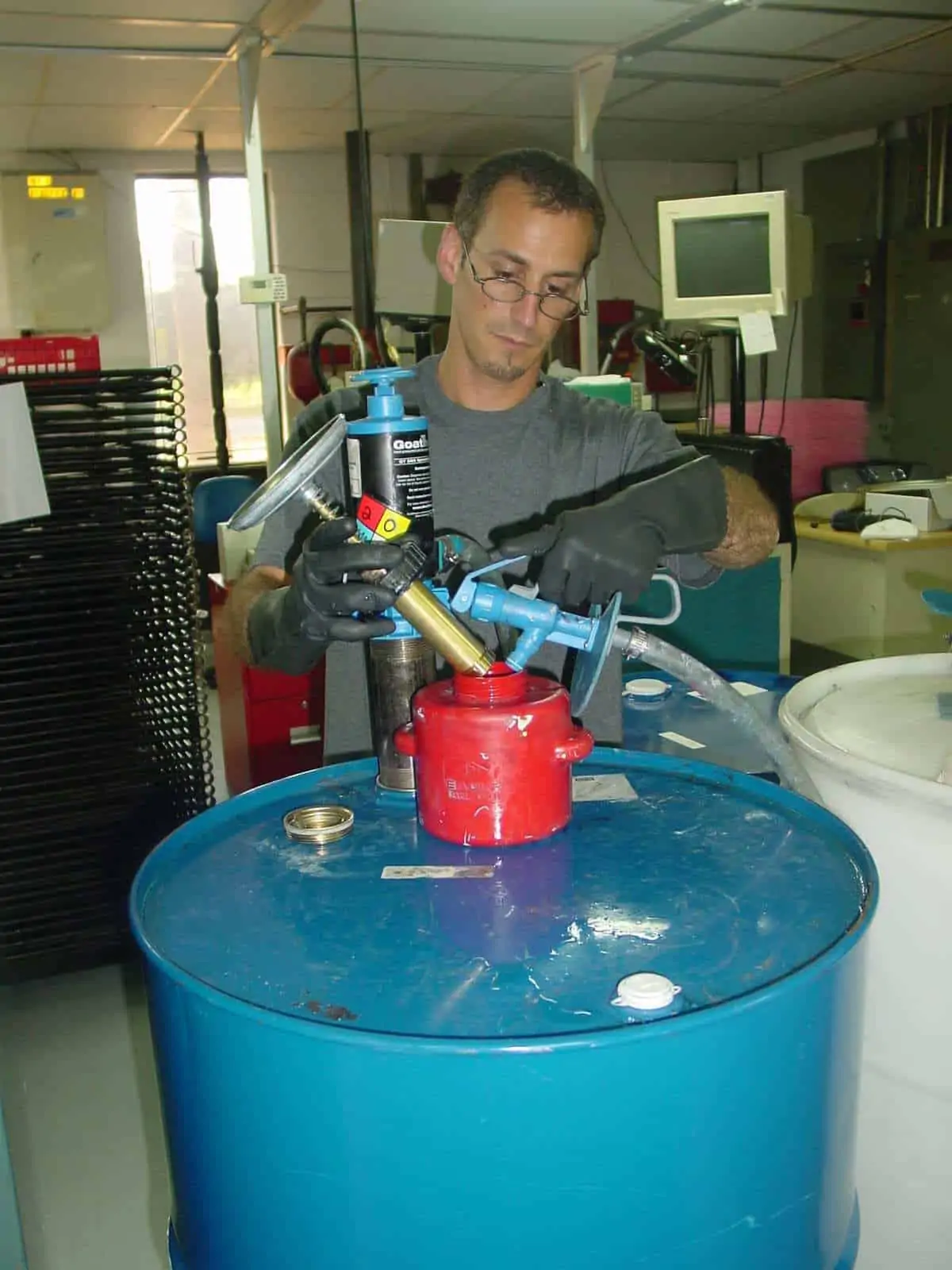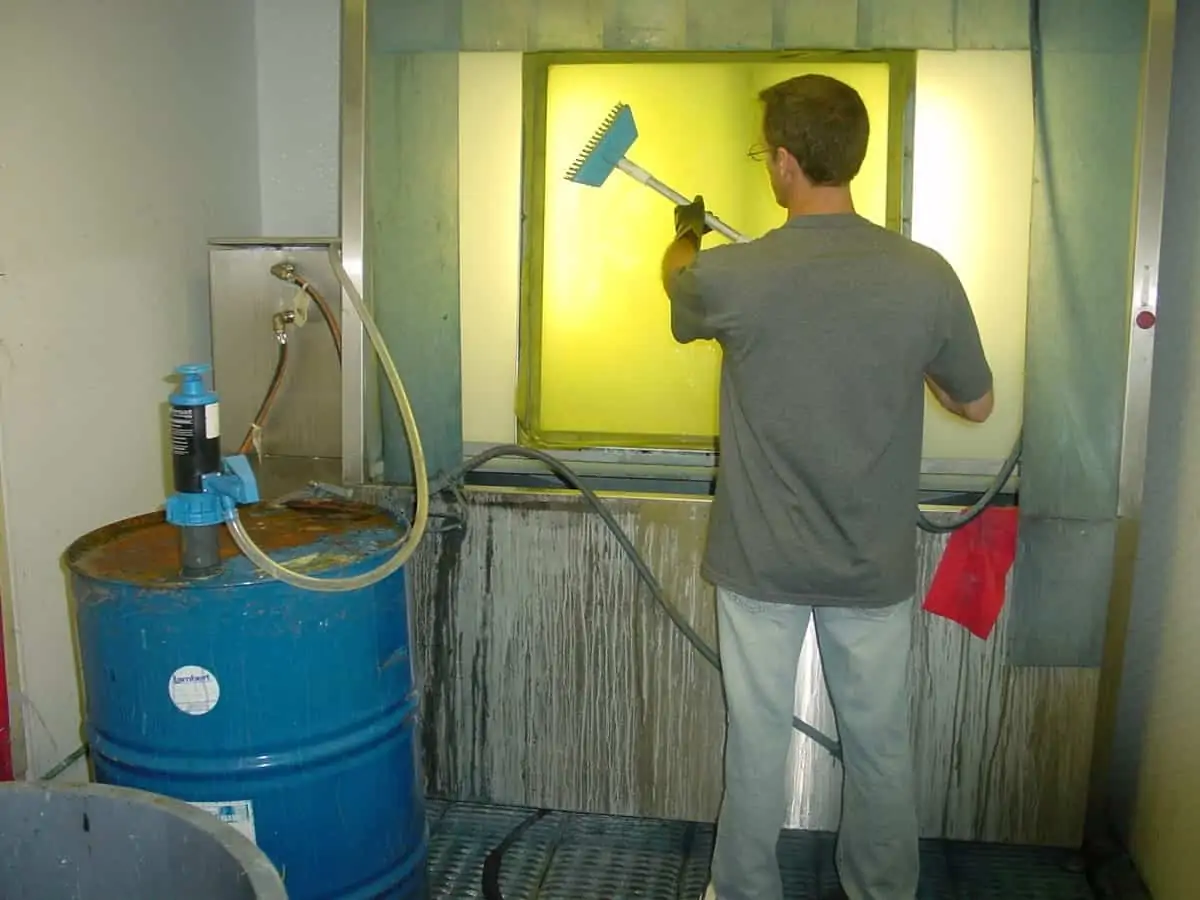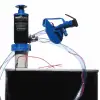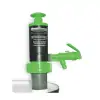Recommended by several chemical companies, there is no doubt that GoatThroat® Pumps improve reliability and safety in printing environments. Users all agree that spill prevention beats clean up with solvents, acids, and other corrosives. With the cost of chemicals, many facilities use GT Pumps because they are safe for contact with over 1700 chemicals and meet exacting requirements. The sealed system is essential in such environments because it reduces vapors and emissions and allows for complete control over the volume of liquids dispensed. The SCP Line of Pumps which are made of static conductive plastic allows these pumps to be used with flammable liquids meeting both NFPA 77 and NFPA 30 requirements. All non-SCP pumps are made from Food Grade materials making them safe for food contact.
Download Library.
Click on a title to download.
Recommended Products
GoatThroat Groundable Santoprene Pump and TapShop Now
GoatThroat Viton PumpShop Now
Pneumatic Adapter with RegulatorShop Now
Case Studies.
Hi Tech Printer Solves Solvent Transfer with Simple System
Hi Tech Printer Solves Solvent Transfer with Simple System Every day industrial workers transfer potentially hazardous chemicals, such as solvents, acetones, lubricants, cleansers, and acids, from large drums into smaller containers, or into machinery. This transfer of chemicals at the point of use, however, can have serious consequences when manual “tip-and-pour” techniques or poorly designed pumps are used.Whether the chemicals are toxic, corrosive, reactive, flammable, emit volatile organic compounds (VOCs), or are even potentially explosive, the danger of accidental contact, even for short periods, can pose a severe hazard to workers.In addition to the potential for injury, there can also be serious financial ramifications for the facility involved. The risks include cost to treat injuries or perform cleanup, as well as workers’compensation claims, potential liability, OSHA fines, loss of expensive chemicals and even facility/production shutdown.“It can be catastrophic to a company if toxic or highly flammable material is accidentally released …
Hi Tech Printer Solves Solvent Transfer with Simple System
Hi Tech Printer Solves Solvent Transfer with Simple System
Every day industrial workers transfer potentially hazardous chemicals, such as solvents, acetones, lubricants, cleansers, and acids, from large drums into smaller containers, or into machinery. This transfer of chemicals at the point of use, however, can have serious consequences when manual “tip-and-pour” techniques or poorly designed pumps are used.Whether the chemicals are toxic, corrosive, reactive, flammable, emit volatile organic compounds (VOCs), or are even potentially explosive, the danger of accidental contact, even for short periods, can pose a severe hazard to workers.In addition to the potential for injury, there can also be serious financial ramifications for the facility involved.
The risks include cost to treat injuries or perform cleanup, as well as workers’compensation claims, potential liability, OSHA fines, loss of expensive chemicals and even facility/production shutdown.“It can be catastrophic to a company if toxic or highly flammable material is accidentally released at the point of use,” says Deborah Grubbe, PE, C.Eng, and founder of Operations and Safety Solutions, a consulting firm specializing in industrial safety. “Companies have to assume that if something can go wrong during chemical transfer; it will, and take appropriate precautions to prevent what could be significant consequences.”
Spiraling Costs of Loss of Containment
Ms. Grubbe, who has 40 years of experience working in the chemical, oil and gas industries,including at DuPont, NASA, and for the U.S. military, says “Any time you lose containment; you have an issue that can spiral out of control.”Corrosive chemicals, for example, can burn skin or flesh. Some chemicals are toxic when touched or inhaled. Cyanotic agents, for instance, can be particularly dangerous or even fatal,since they rob the body of oxygen.Many chemicals are flammable as well and can be ignited by even the smallest spark from nearby motors or other mechanical equipment. “There is no such thing as a small fire in my business,” says Ms. Grubbe.
In addition to cost of cleanup or treating injuries, there are also indirect costs that can be incurred. These include supervisors’ time to document the incident and respond to any added government inspection or scrutiny, as well as the potential for temporary shutdown of the facility.“The indirect costs can be as much as 2-4 times the direct costs,” says Ms. Grubbe. “Not to mention potential liability, workers’ compensation issues, regulatory fines or potential actions from OSHA or the EPA.”
Chemical Transfer Techniques
Traditional practices of transferring liquid chemicals suffer from a number of drawbacks. Manual techniques, such as the tip-and-pour method, are still common today. Tipping heavy barrels, however, can lead to over-pouring or the barrel toppling.“Some companies choose to transfer of chemicals manually, but it is extremely difficult to control heavy drums,” cautions Ms. Grubbe. “I’d recommend against it because of the probability of a spill is so high.”Although a number of pump types exist for chemical transfer (rotary, siphon, lever-action,piston and electric), most are not engineered as a sealed, contained system.
In addition, these pumps can have seals that leak, are known to wear out quickly, and can be difficult to operate,making precise volume control and dispensing difficult.In contrast, sealed pump systems can dramatically improve the safety and efficiency of chemical transfer.“A sealed, contained system is ideal when dealing with a toxic, flammable, or corrosive liquid,”says Grubbe. “With sealed devices, like GoatThroat pumps, you can maintain a controlled containment from one vessel to another.”Small, versatile, hand-operated pressure pumps are engineered to work as a sealed system. The pumps can be used for the safe transfer of over 1,400 industrial chemicals, including the most aggressive acids, caustics and solvents.These sealed-system pumps function essentially like a beer tap. The operator attaches the pump, presses the plunger several times to build up a low amount of internal pressure, and then dispenses the liquid.
The tap is configured to provide precise control over the fluid delivery, from slow (1ML/ 1 oz.) up to 4.5 gallons per minute, depending on viscosity.Because such pumps use very low pressure (<6 PSI) to transfer fluids through the line and contain automatic pressure relief valves, they are safe to use with virtually any container from 2-gallon jugs to 55-gallon drums.
Adoption of Sealed Pump Systems
Although Design Mark Industries keeps its chemicals in a vented, explosion-proof room, the supplier of membrane switches, keypads, and touchscreens sought to further improve the safety and efficiency of transferring acetone and acetate-based chemicals from 55-gallon drums into quart and 5-gallon containers. The chemicals are used in the screen printing process of printed circuitry and graphic overlays.Production Supervisor Vincent Francisco ruled out manual pouring because of the potential of injury and lack of control in dispensing. Instead, he utilized a variety of traditional pumps including rotary, siphon, and lever-action, but found them all unsatisfactory.“I was replacing the pumps once or twice a year because they kept breaking down, delivered imprecise amounts, and were not designed as completely self-contained, sealed systems,”says Mr. Francisco.
After considerable research online, Mr. Francisco decided to utilize a sealed chemical pump system. He considers them a “best practice” technique because the barrel remains upright during the entire transfer process and there is no exposure to VOC vapours. According to Mr. Francisco, the sealed pump system is intuitive to use because it operates like a beer tap. “Just pump the plunger a few times, open the spigot and dispense. You have full control over how much is dispensed – even the tiniest amounts – or you can leave it open for a continuous flow.
It delivers the precise amount needed.”Mr. Francisco adds that the pumps are built for longevity. Over the past 11 years, he estimates that his company has saved thousands of dollars by eliminating the cost of replacement pumps. “I’ve only replaced one of our three pumps over that time due to constant use, and we could have used it longer,” says Mr. Francisco.
Allergy Laboratories Inc., a FDA licensed pharmaceutical manufacturer of biological extracts for the diagnostic testing and therapeutic treatment of allergies, also uses a sealed pump system to transfer acetone from 55 gallon drums to 1 gallon containers for a variety of processes. According to Charles Cheek, facility manager for Allergy Laboratories, the pharmaceutical chemical delivery process must be very clean and no foreign material can be introduced into the acetone.
Because acetone is highly flammable, he was concerned about using an electric pump that could potentially create a spark. As a result, he decided to purchase a pump that had no Electrical or moving parts that could create a hazard. The company found sealed-system pumps to be a much safer way to transport chemical liquids. “There is no spillage, splatter, overpouring, leaking, or VOCs because the system is self-contained. There is no sprayback and we do not get chemicals on our hands. It is a nice,clean delivery system” stated Mr. Cheek.Besides enhancing safety, Mr. Cheek says a sealed system can prevent loss of expensive chemicals like acetone. “I haven’t lost any product due to the pumps. They eliminate evaporation, do not leak or drip and I can adjust the flow to get the exact amount I need without spilling or overflow.”
Mr. Cheek says he also utilizes a sealed-system pump to transfer comprehensive boiler water treatment solution to mitigate scale and corrosion of the boiler system. Previously, he had to fill a glass beaker with the chemical, climb a ladder and pour the chemicals into the top of the tank. Now, that work is performed with the help of the pump and 6’ extension hose accessory to efficiently deliver the cleaning chemicals. “Every time inspectors come in, they say we have the cleanest boiler they have seen,” says Mr.Cheek. “With this chemical transfer system, I’m able to transfer exactly what I need to get the job done.”






